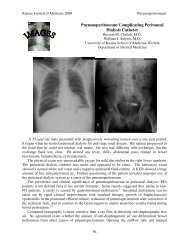The Silence of Neurosyphilis - Archie Home
The Silence of Neurosyphilis - Archie Home
The Silence of Neurosyphilis - Archie Home
Create successful ePaper yourself
Turn your PDF publications into a flip-book with our unique Google optimized e-Paper software.
Kansas Journal <strong>of</strong> Medicine 2011 <strong>The</strong> <strong>Silence</strong> <strong>of</strong> <strong>Neurosyphilis</strong><br />
Discussion<br />
Medical advancements during the 20 th<br />
century have included antibiotics which<br />
have enabled physicians to provide potential<br />
cures for infections. Treponema pallidum<br />
subspecies pallidum is a bacterium under the<br />
spirochete family, taking its name from its<br />
microscopic appearance. 3,4 T. pallidum is a<br />
sexually transmitted infection that<br />
progresses through four stages: primary,<br />
secondary, tertiary, and latent. <strong>The</strong> former<br />
three stages usually occur within one year <strong>of</strong><br />
inoculation. When transmitted in-utero, the<br />
infection is referred to as congenital<br />
syphilis.<br />
Primary syphilis manifests after 2-3<br />
weeks incubation after infection. A painless<br />
papule appears at the site which ruptures<br />
into a painless chancre ulcer with indurated<br />
margins and a non-exudative base. 3 Bilateral<br />
regional lymphadenopathy then develops.<br />
Patients tend not to address these lesions<br />
because they are painless and feel<br />
embarrassed to expose themselves.<br />
Chancres eventually heal within 3-6 weeks,<br />
while the spirochete disseminates freely.<br />
Secondary syphilis may develop in 25%<br />
<strong>of</strong> those infected and usually is seen 3-6<br />
months after the resolution <strong>of</strong> the chancre. 4<br />
114<br />
Figure 4. MRA showed no vascular<br />
occlusion in the posterior left middle<br />
cerebral artery distribution.<br />
It most commonly presents as diffuse<br />
symmetric maculopapular lesions that occur<br />
non-sparingly over the body, including<br />
palms and soles. 5 <strong>The</strong>re is also systemic<br />
constitutional symptoms and diffuse<br />
lymphadenopathy as well other skin,<br />
gastrointestinal, hepatic, musculoskeletal,<br />
renal, and ocular manifestations. It is during<br />
secondary syphilis where the cerebrospinal<br />
fluid is infiltrated. 3<br />
Tertiary syphilis, also known as late<br />
syphilis, includes neurosyphilis which<br />
presents with gummas, described as ulcers<br />
or an aggregation <strong>of</strong> granulomas that may<br />
occur anywhere in the body, from skin to<br />
bone. 6 Heart manifestations are usually<br />
dilatation and calcification <strong>of</strong> the aortic root<br />
and arch in addition to coronary artery<br />
narrowing with potential thrombosis. 7<br />
<strong>Neurosyphilis</strong> presents depending on the<br />
affected region <strong>of</strong> the nervous system. 8<br />
Early neurosyphilis usually involves the<br />
cerebrospinal fluid (CSF), meninges, and<br />
vasculature and may either be asymptomatic<br />
or symptomatic. Late neurosyphilis usually<br />
affects the brain and spinal cord.<br />
Asymptomatic neurosyphilis may occur any<br />
time after infection but usually within











